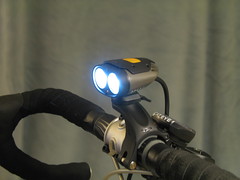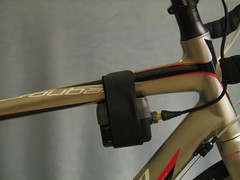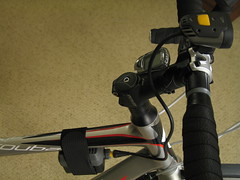Princeton Tec Switchback 2 Summary
Good for: Casual trail riding, epic five hour treks into the backcountry (and back), long training rides on dark roads, any kind of city riding. If you bike commute and actually need the 5+ hours of burn time, I salute you. Except you probably don't have time to read this review.Probably not for: Competitive singletrack at night. The Switchback 2 provides enough light to illuminate the branch just as it thwacks you in the head. Get something brighter, like the Switchback 3.
What about the Switchback 1? Princeton Tec markets the Switchback 1 as "the perfect secondary light," but at $199 it's a bit spendy for that. A good LED backup is a good investment for those relying on high power HID systems, some of which are prone to sudden failure. The Switchback 1 is certainly brighter than the dim blinkies that most night cyclists use. If you need a primary light, I'd spring for the extra $70 and get the Switchback 2.
Princeton Tec has been selling lights for outdoor enthusiasts for 30 years. In 2005, Princeton Tec began marketing a couple of their existing headlamps to cyclists by modifying straps to make them helmet-mountable. Lights designed for 1 mph hikes, however, don't provide much visibility for cyclists.
For 2007, Princeton Tec has introduced several good bike-specific designs, including three versions of the "Switchback" LED light. The Switchback is a reincarnation of a now-discontinued incandescent headlamp; I happen to own one that I used for backpacking before the advent of LED headlamps.
Princeton Tec has designed the Switchback with endurance racers and commuters in mind. I don't ride singletrack in the middle of the night, so I'll give my views from my perspective as a year-round bike commuter.
I've tried the two LED Switchback 2. I don't have any way to scientifically measure the lumen output of this light, but the two 3W "Maxbright" LEDs are comparable in brightness to 10W+20W halogen systems that many of us are familiar with. The lens focuses a fairly tight and round beam, easily illuminating obstacles and debris several yards ahead. I can comfortably ride about 20 mph on a dark road with this light at high power.
The flash mode is interesting and useful in my opinion. Most LED lights have a "blink" mode to preserve battery life and enhance visibility by motorists, but it can be difficult to navigate when the front light constantly strobes. The Switchback's blink mode blinks rapidly twice then stays steady for a second before cycling back to blinking. I haven't tried this yet in real conditions, but this seems to provide the "be seen" benefit of a blink with the "see" benefit of a steady bright light.
The battery has a built-in battery life indicator -- red and green LEDs shine through the transluscent case to show the level of charge. I've lost my lights in the middle of a ride from a yanked cable, so I appreciate the locking cable connectors.
Quite a bit of thought has apparently been put into the design of the Switchback bicycle light. The light itself has a sleek, low profile that I like much better than the bulky headlights I usually see from other vendors. The handlebar mount is a little large, but I like the design, it works on good range of handlebar sizes (unlike some mounts I've tried), and the quick-release works very well. If you need to change the direction the light points because, for example, you mount the light on a curving part of the handlebar, a small allen key is required to loosen a bolt to allow adjustment.
Velcro straps to mount the light to a bicycle helmet are straightforward. A unique rubber case with wide velcro straps allow the battery to be mounted on the frame or handlebar or even the saddle rails. A provided extension cord provides additional flexibity in battery location.
The Switchback 2 bike lamp probably isn't quite enough for singletrack racing at night, but it provides plenty of light for night time training rides and the evening commute home.
For 2007, Princeton Tec has introduced several good bike-specific designs, including three versions of the "Switchback" LED light. The Switchback is a reincarnation of a now-discontinued incandescent headlamp; I happen to own one that I used for backpacking before the advent of LED headlamps.
Princeton Tec has designed the Switchback with endurance racers and commuters in mind. I don't ride singletrack in the middle of the night, so I'll give my views from my perspective as a year-round bike commuter.
Switchback bike light specs
Princeton Tec Switchback bicycle light comes in three models: Switchback 1 with one 3 watt LED, Switchback 2 with two 3 watt LEDs, and the Switchback 3 with (wait for it) three 3 watt LEDs. Each of these lamps features a quick smart charger with universal plug adapters, hours of burn time, lightweight lithium-ion battery, voltage regulated to ensure constant brightness, 12 volt car charger, helmet and handlebar mounts, and extension cords and cable straps. Here are the specifics of each model.| Model | Burn Time | Weight | MSRP |
|---|---|---|---|
| Switchback 1 | 5.5H Flash, 4.5H High, 6H Medium, 10H Low | 436 grams | $199 |
| Switchback 2 | 6H Flash, 5.5H High, 7H Medium, 16H Low | 586 grams | $269 |
| Switchback 3 | 6.5H Flash, 6H High, 12H Medium, 50H Low | 826 grams | $389 |
Using the Switchback 2
Click on photos to see large.

The Princeton Tec Switchback 2 bicycle light mounted on my handlebar. Two 3 Watt LEDs provide illumination that can be seen even in light.

The battery pack mounted on the top tube of my bike frame. The battery can also be mounted on the handlebar or placed in a hydration pack or jersey pocket.

Battery and light connected. Instead of one annoyingly long cable, the headlight has a short cable. If you need the battery further away, use the included extension cable.

The Princeton Tec Switchback 2 bicycle light mounted on my handlebar. Two 3 Watt LEDs provide illumination that can be seen even in light.

The battery pack mounted on the top tube of my bike frame. The battery can also be mounted on the handlebar or placed in a hydration pack or jersey pocket.

Battery and light connected. Instead of one annoyingly long cable, the headlight has a short cable. If you need the battery further away, use the included extension cable.
I've tried the two LED Switchback 2. I don't have any way to scientifically measure the lumen output of this light, but the two 3W "Maxbright" LEDs are comparable in brightness to 10W+20W halogen systems that many of us are familiar with. The lens focuses a fairly tight and round beam, easily illuminating obstacles and debris several yards ahead. I can comfortably ride about 20 mph on a dark road with this light at high power.
The flash mode is interesting and useful in my opinion. Most LED lights have a "blink" mode to preserve battery life and enhance visibility by motorists, but it can be difficult to navigate when the front light constantly strobes. The Switchback's blink mode blinks rapidly twice then stays steady for a second before cycling back to blinking. I haven't tried this yet in real conditions, but this seems to provide the "be seen" benefit of a blink with the "see" benefit of a steady bright light.
The battery has a built-in battery life indicator -- red and green LEDs shine through the transluscent case to show the level of charge. I've lost my lights in the middle of a ride from a yanked cable, so I appreciate the locking cable connectors.
Quite a bit of thought has apparently been put into the design of the Switchback bicycle light. The light itself has a sleek, low profile that I like much better than the bulky headlights I usually see from other vendors. The handlebar mount is a little large, but I like the design, it works on good range of handlebar sizes (unlike some mounts I've tried), and the quick-release works very well. If you need to change the direction the light points because, for example, you mount the light on a curving part of the handlebar, a small allen key is required to loosen a bolt to allow adjustment.
Velcro straps to mount the light to a bicycle helmet are straightforward. A unique rubber case with wide velcro straps allow the battery to be mounted on the frame or handlebar or even the saddle rails. A provided extension cord provides additional flexibity in battery location.
The Switchback 2 bike lamp probably isn't quite enough for singletrack racing at night, but it provides plenty of light for night time training rides and the evening commute home.
2 comments:
Great blog, great info! If you're not already a member of the www.bikeforums.net community, please stop by and have a look. It's free, and there are plenty of members that share your enthusiasm.
Many bike shops should be able to get the lights. I work at two and both have recieved ordering info, and a co-worker and I have just ordered a set. Try the local bike shops first!
Post a Comment